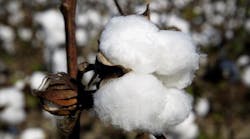Kenya plans to revive its cotton industry, a major foreign-exchange earner until the 1980s, amid strong demand for lint from domestic mills and the potential to supply manufacturers exporting clothing and textiles to the U.S. under a preferential trade deal.
The government is planning training and credit facilities for farmers as part of a bid to restore production that peaked at 38,000 metric tons of seed cotton in 1984-85. Kenya currently produces 15,700 tons of seed cotton, creating about 5,240 tons of lint. Demand for the latter is about 37,000 tons, with the shortfall imported from neighboring countries, according to Fanuel Lubanga, a development manager at the state-run Agriculture and Food Authority.
The initiative comes as manufacturers in East Africa’s biggest economy are counting on apparel exports to the U.S. growing 5% this year after the U.S. extended its African Growth and Opportunity Act, or AGOA, by a decade.
“The potential that we have for our cotton through the AGOA exports is a strong motivation to grow the industry,” Lubanga said in an interview in the capital, Nairobi. He said national output is expected to double during the 2017 harvest because farmers are now using seeds bought from Israel instead of recycling seeds, previously a common practice.
East Africa could potentially export garments valued at as much as $3 billion annually by 2025, according to a 2015 McKinsey report. Affordable electricity and cheap labor--with monthly salaries as low as $60--make producers such as Kenya and Ethiopia attractive to investors, the study shows.
Export Zones
Kenya exported clothing valued at $380 million in 2015, with companies including Puma SE, Wal-Mart Stores Inc., JC Penny Co. and Hennes & Mauritz AB among those who source garments from Kenyan Export Processing Zones, which employ more than 66,000 people. While EPZ manufacturers currently use no domestically grown cotton, instead importing Asian fabrics, the Industry Ministry is working on ways for Kenyan farmers to secure contracts to sell to them, Lubanga said.
The six-member East African Community, which includes Kenya, is working to revamp the domestic garment market by banning secondhand clothes imports at the end of 2018, the Kenya Association of Manufacturers said in April. Rwanda has already banned imports of leather, secondhand clothes and shoes, the governor of that country’s central bank said earlier in November. Kenya imported used clothing worth $243 million and weighing more than 100,000 tons in 2013, according to data by the United Nations agency Comtrade.
Kenya’s textile industry declined in the 1980s after market liberalization policies demanded by multilateral lenders exposed the market to secondhand imports. The country now has six cotton mills compared to 52 in 1991, while there are four ginneries, compared with 24 that year.
“Turkish investors have shown interest to grow cotton on a large scale in Siaya,” Lubanga said, referring to a county in southwestern Kenya, without giving more information.
U.S. grown cotton, which closed trade at 73.08 cents per pound on the ICE Futures U.S. on Nov. 23, has gained 13% this year.
Demand for lint “is still high, both locally and internationally,” Lubanga said. “The prices have been high in the past few years, which we hope will remain at similar levels.”




